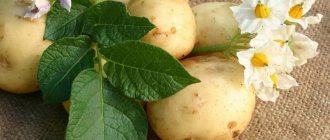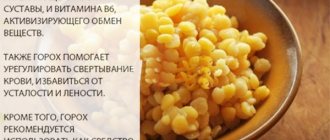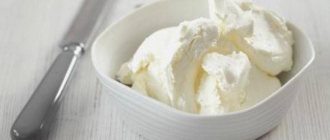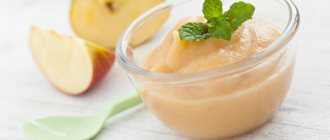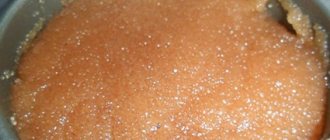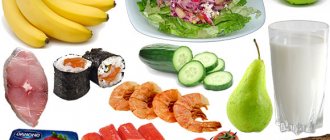The calorie content of fresh green peas per 100 grams is 73 kcal. 100 g of legumes contains:
- 5 g proteins;
- 0.2 g fat;
- 13.8 g carbohydrates.
The vitamin and mineral composition of fresh green peas is represented by vitamins A, B1, B2, B3, B5, B6, B9, E, H, sulfur, phosphorus, potassium, chlorine, calcium, silicon, magnesium, sodium, zinc, manganese, iron.
The calorie content of canned green peas per 100 grams is 55 kcal. The product contains 3.6 g of protein, 0.1 g of fat, 9.8 g of carbohydrates.
Canned peas are considered one of the healthiest canned vegetable products. It contains large quantities of fiber, carbohydrates, potassium, iron, zinc, phosphorus, B vitamins, and vitamin C.
Canned green peas help lower cholesterol levels, saturate the body with strength and energy, stimulate brain function, and activate the immune system.
Benefits of fresh green peas
The benefits of fresh green peas are as follows:
- green peas effectively block radioactive metals entering the body;
- The diuretic effect of green peas and the preventive properties of the product against kidney stones have long been known;
- Regular consumption of green peas reduces the risk of developing cancer, strengthens the immune system, and reduces the likelihood of hypertension and heart attack;
- fresh green peas are indicated for atherosclerosis, anemia, ulcers, diabetes;
- the antioxidant properties of the product have been confirmed;
- Doctors recommend green peas for vitamin deficiency.
Harm of fresh green peas
The harm to fresh green peas often occurs when you overeat legumes. The product is contraindicated in case of exacerbations of stomach and intestinal diseases, tendency to flatulence, bloating.
It is mandatory to limit the amount of green peas consumed for gout.
To prevent flatulence when eating fresh green peas, it is recommended to thoroughly rinse the peas and soak them in cold water for a while.
Dried peas are rich in vitamins B, A and ascorbic acid. It contains a lot of iron, phosphorus, calcium, potassium, zinc, magnesium.
The calorie content of peas boiled in water per 100 grams is 59.8 kcal. In 100 g of product:
- 5.9 g protein;
- 0 g fat;
- 9.1 g carbohydrates.
Boiled peas are enriched with vitamins B, A, E, C, PP, minerals sulfur, magnesium, potassium, iodine, sodium, calcium, chlorine. Regular consumption of such dishes normalizes the functioning of the heart and blood vessels, accelerates metabolism, lowers blood pressure, reduces cholesterol in the blood, and cleanses the intestines of toxins.
Percent Daily Value
| Component | Quantity per 100 g of finished product | Part of the daily value |
| cellulose | 2.7 g | 14 % |
| Vitamin A (retinol equivalent) | 17.4 mcg | 1,9 % |
| IN 1 | 0.115 mg | 7,7 % |
| AT 2 | 0.036 mg | 2 % |
| AT 5 | 0.537 mg | 11 % |
| AT 6 | 0.084 mg | 4,2 % |
| AT 9 | 4.813 mcg | 1,2 % |
| WITH | 0.65 mg | 0,7 % |
| D | 0.039 mcg | 0,4 % |
| E | 1.024 mg | 6,8 % |
| N | 4.6 mcg | 9,1 % |
| RR | 1.58 mg | 7,9 % |
| beta carotene | 0.012 mg | 0,2 % |
| water | 75 g | 2,7 % |
| potassium | 187 mg | 7,5 % |
| calcium | 28.6 mg | 2,9 % |
| magnesium | 22 mg | 5,5 % |
| sodium | 133 mg | 10 % |
| sulfur | 48,5 % | 4,9 % |
| phosphorus | 59.1 mg | 7,4 % |
| chlorine | 211 mg | 9,2 % |
| iron | 1.7 mg | 9,3 % |
| iodine | 13.4 mcg | 8,9 % |
| cobalt | 2.7 mcg | 27 % |
| manganese | 0.19 mg | 9,6 % |
| copper | 147.3 mcg | 15 % |
| fluorine | 69.07 mcg | 1,7 % |
| chromium | 0.26 mcg | 0,5 % |
| zinc | 0.67 mg | 5,6 % |
| cholesterol | 4.9 mg | 1,6 % |
We suggest you familiarize yourself with the correct transplantation of lemons into a new pot at home
Calorie content of fried peas per 100 grams
The calorie content of fried peas per 100 grams is quite high and amounts to 170 kcal. A 100 gram serving contains:
- 5.1 g protein;
- 13 g fat;
- 8.4 g carbohydrates.
Doctors and nutritionists do not recommend overusing this dish. Fried peas are allowed in very limited quantities when losing weight and during a diet. It should be avoided in case of cholecystitis, pancreatitis, inflammatory processes of the stomach and intestines. When overeating fried peas, flatulence, diarrhea, constipation and other disturbances in the gastrointestinal tract occur.
Is it possible to have pea puree while losing weight?
Should you include boiled peas in the diet of someone losing weight? Of course yes! The rich structure of microelements and low calorie content allow you to use the product while losing weight.
Pea cereal dishes should be eaten 1-2 times a week. Lenten porridge with water is an excellent choice for lunch.
For those who want to speed up the process of weight loss, several options for the pea diet are offered:
- Fasting day. During the day you are allowed to eat 3-4 times and only boiled food, cooked in water with a minimum amount of salt. One meal -250-300 g.
- Three-day program. It is allowed to eat 250 g of peas 1-2 times a day; fresh vegetables, fruits and berries can be used as a snack.
- Weekly. The basic menu includes peas, vegetables, herbs and dairy products. Meat and fruit in limited quantities.
Nutritionists do not recommend using harsh methods of losing weight. Mono-diets and express programs lead to disruption of metabolic processes. You can lose extra pounds without harm to your health only by eating a balanced diet.
Benefits of green peas
The following benefits of green peas have been proven:
- the product is saturated with citric and oxalic acids, which are necessary for kidney stones and sand;
- the diuretic properties of green peas make it possible to use it if you are prone to edema;
- the product is enriched with fiber, which stimulates the functioning of the stomach and intestines and removes toxins from the body;
- minerals and vitamins of green peas are beneficial for the health of the heart and blood vessels, and provide effective prevention of blood clots and hypertension;
- legumes contain a lot of iodine and iron - minerals that prevent anemia;
- with regular consumption of legumes, metabolism is restored, the aging process of the body is inhibited, and a powerful antioxidant effect is exerted;
- peas normalize fat metabolism and lower the level of bad cholesterol;
- Green peas, due to their large amount of B vitamins, are useful for stimulating brain function.
Harm of green peas
You should avoid eating green peas if:
- circulatory disorders;
- exacerbations of gastrointestinal diseases;
- with a tendency to bloating and flatulence;
- diagnosing diseases of the gallbladder and ducts, as well as the pancreas.
To eliminate the "blowing" properties of peas, they should be soaked in water before boiling for 12 hours.
Peas are a plant of the legume family; their fruits are eaten both fresh or frozen, and dried and cooked. This is a universal product from which you can prepare both the first and second course, and salad. The composition of peas is unique - it has a very high content of vitamins and minerals, and in terms of protein content, peas are close to meat - they contain more than 20%. Moreover, these proteins contain almost all the amino acids necessary for humans, including essential ones, and they are absorbed much better than proteins of animal origin.
Almost half the mass of peas (dried) is made up of carbohydrates - these are slow carbohydrates, thanks to which peas saturate and energize for a long time. Carbohydrates are the main source of calories in peas.
This product also contains a lot of fiber - more than 11% of the mass. Thanks to its presence, peas have a cleansing effect on the body and remove not only waste and toxins, but also excess cholesterol, and also stimulate intestinal motility and fight constipation. The high content of B vitamins makes peas a natural antidepressant; these vitamins stimulate brain activity, improve the functioning of the nervous system, reduce fatigue and normalize sleep, as well as increase stress resistance and improve mood. Peas also contain:
- vitamin PP, useful for blood vessels and blood;
- beta-carotene;
- vitamin A, necessary for skin and good vision;
- vitamin E, which has antioxidant properties;
- biotin, which improves the condition of skin, hair and nails and increases endurance during physical activity;
- choline, necessary for all synthesis processes in the body.
Peas are rich in calcium, which is essential for bone tissue. It also contains magnesium, which is involved in all processes occurring in the body, sulfur, chlorine, sodium, zinc, copper, manganese, iron, iodine, phosphorus, fluorine and other micro- and macroelements that are extremely important and beneficial for the body. Selenium helps prolong youth and blocks the entry of toxic substances from the outside into the body; Thanks to other elements, peas have a beneficial effect on bones, blood vessels, the condition of teeth, nails, skin, hair, improves energy metabolism, and enhances regeneration processes in the body.
The potassium contained in large quantities in peas deserves special attention - it not only removes excess salt from the body, preventing the occurrence of edema, but also strengthens muscles and improves their function, including the work of the heart muscle.
The calorie content of dry peas is 298 kcal per 100 g
. When cooked, it increases several times, saturated with water, so the calorie content of cooked peas is much lower. Boil peas in water for at least 40 minutes, during which time they increase in volume by 3-5 times (the calorie content of peas per 100 g decreases by the same amount). The volume of peas will increase even more if you fill them with water for several hours (or overnight).
The calorie content of fresh green peas is 55 kcal per 100 g. When frozen, pea grains lose moisture, and the dry mass per unit volume increases accordingly, so the calorie content of frozen green peas is higher and is 75 kcal per 100 g.
You should not overuse fresh or thawed green peas - they are a fairly rough food containing a lot of fiber, so they can injure the mucous membrane of the stomach or intestines, and can also cause increased gas formation.
Peas contain citric acid, which helps break down fats; it has a mild diuretic, choleretic and laxative effect, it also has anti-carcinogenic properties and helps dissolve kidney stones.
Calorie content of cooked peas
Porridge, purees, soups and canned food are traditionally prepared from peas. The calorie content of pea puree from boiled peas without adding oil will be only 60 kcal per 100 g (in an average portion 220-240 g). If you add butter or margarine when preparing a dish, then the calorie content of pea puree will be about 120-130 kcal per 100 g
. Pea porridge and pea puree differ in consistency; they are almost the same in composition and calorie content (deviations arise due to different thicknesses, the use of oil during cooking, etc.).
The calorie content of pea soup is affected by its thickness and additional ingredients. Medium-thick pea soup without frying, meat, sausages, etc. contains 60-65 kcal per 100 g. The calorie content of pea soup with fried and smoked meats will already be 73-78 kcal per 100 g. The thicker the soup, the more calories it will contain. The most high-calorie pea soup is a soup that contains roasting, smoked meats, sausages, lard or cracklings.
The calorie content of canned peas depends on what additives manufacturers use
– Many people add sugar to canned food to make peas sweeter, which increases their calorie content. The proportion of brine and pea beans in the jar also matters. For example, the calorie content of canned peas of the Veres brand is 38 kcal per 100 g, the product contains 52 kcal per 100 g, and green peas contain 70 kcal per 100 g.
Pea diet
Despite the fact that the calorie content of peas can hardly be called low, its beneficial and dietary properties are so great that a pea diet was developed on its basis.
Nutritionists promise that with this diet you will lose 2-5 kg per week. The pea diet is simple, affordable and well tolerated.
The downside is that weight loss occurs not only due to fat burning, but also due to muscle tissue atrophy. To avoid this, you must exercise while dieting.
The diet menu is simple: every day at lunch you must eat a dish made from peas - soup, puree, porridge, etc. Breakfast is made up of cereals and fermented milk products; for dinner it is suggested to eat fresh or boiled (stewed) vegetables. You can eat berries and fruits as snacks. During the diet, meat dishes are not consumed - the body gets all its protein from peas.
The high calorie content of peas provides the human body with energy
, and the absence of animal fats in the diet has a positive effect on your figure.
This diet improves digestion, speeds up metabolism and promotes fat burning, while your mood improves, the condition of your hair, nails and skin improves, and your performance increases. If you liked this article, please vote for it:
(4 Votes)
Peas are considered one of the most popular annual plants among legumes. It was grown and cultivated by our ancestors about 3000 years ago. Peas have long been valued for their enormous nutritional value and the presence of many useful substances in its composition.
Peas contain B vitamins, as well as vitamins A, C, PP, not to mention a large amount of minerals (potassium, selenium, iron, phosphorus, magnesium, chlorine, sulfur, etc.). In addition, it contains pyridoxine and the important amino acid lysine, and the large amount of protein in peas makes it an alternative replacement for high-calorie meat products, because the calorie content of peas itself is low.
In this article we will look at how many calories are in peas, depending on their type and method of preparation, and also determine the calorie content of peas in ready-made dishes.
Healthy food recipes
In cooking, this product is widely valued not only for its special taste and rich vitamin content, but also for its nutritional value. The range of dishes is wide and varied. Boiled peas or in combination with other food additives are especially useful. All recipes are very easy to prepare, so even an inexperienced cook can handle them.
Recipe for dietary pea sausage
This dish will be an excellent alternative to a meat product for vegetarians and fasting people.
Ingredients that should be included:
- boiled peas - 200 grams;
- garlic;
- sunflower oil 40–50 ml;
- spices;
- beet juice;
- salt.
Grind the peas into a homogeneous mass, add all the other ingredients, mix well. Place it in a container to give it a certain shape and put it in a cool place. After 5–6 hours, we take out the finished sausage and decorate it with herbs.
Pie with peas and onions
This pastry will surprise you with its unusual taste and crumbly dough. To prepare you will need:
- boiled peas;
- odorless vegetable oil;
- cooled boiled water;
- salt and spices;
- flour;
- onion;
- honey;
- fresh lemon juice.
The process begins with preparing the dough. Flour, salt, baking powder, water, butter are combined and the dough is kneaded. It needs to be removed for some time to settle. The filling will consist of fried onions with the addition of lemon juice and honey. Place a layer of onion on a baking sheet, a layer of pea puree and cover everything with a layer of dough. Bake for about 35–45 minutes.
Thus, we can conclude about the invaluable properties of this legume representative. Only reasonableness and rationality . Everything is good in moderation, do not overdo it with quantity. It is better to find out how much you need exactly from your personal nutritionist. Despite the significant benefits, peas are difficult and take a long time to digest.
How many calories are in different types of peas?
There are three main groups of varieties of this plant. Depending on which group it belongs to, the beneficial properties, method of preparation, nutritional value, and calorie content of peas are determined. For example, shelling peas, which contain round peas and tough shells, are commonly dried for use in entrees, side dishes, and purees. The calorie content of dry peas in this case will be 298-310 kcal per 100 g.
Sugar snap peas are large, fleshy, sweet beans that contain slightly underdeveloped grains. A distinctive feature of this species is that when dried, its grains wrinkle due to the large amount of moisture in raw peas. Its calorie content is slightly higher than that of the representative of the previous species, and is about 320 kcal.
Brain peas also have a round shape, but during the ripening process they begin to shrink, vaguely resembling a human brain. It also contains a lot of sucrose, which gives it a sweetish taste. Brain peas are most often canned or eaten fresh. As a rule, it is not used for cooking, since during heat treatment its grains soften too much and practically dissolve in water. The calorie content of brain peas is practically no different from the calorie content of other types of peas.
Boiled peas of various varieties: calorie content per 100 g
Pea puree, the calorie content of the finished dish from which depends on the method of heat treatment, can be prepared from 2 types of legumes:
- Vegetable snap peas (sugar). This is a green variety, for which the largest peas are selected for canning, freezing or drying.
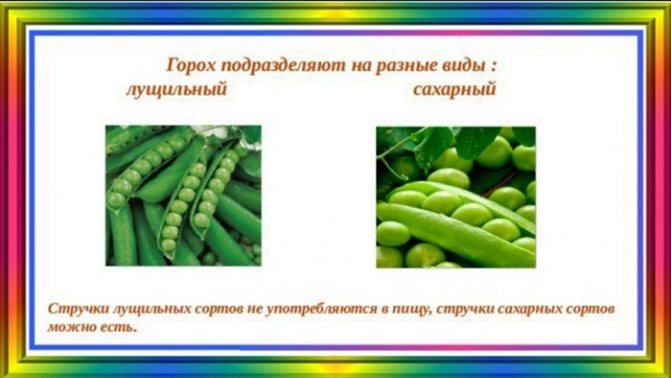
- Cereal varieties that turn yellow at maturity. This type has a long shelf life and hardness, which causes long soaking before cooking.
Pea puree, whose caloric content differs depending on the type of legume, saturates the body with vitamins and microelements, and also provides a surge of energy due to its carbohydrate content.
| Type of culture | Number of calories per 100 g of finished dish | Features of use |
| dry shelling peas | 35 kcal | Suitable for dietary nutrition, as well as making purees, side dishes, and first courses. |
| sugar snap peas | 45 kcal | Suitable for canning |
| brain peas | 80 kcal | Suitable for canning |
Properties, benefits and calorie content of canned and fresh peas
Since this type of legume is considered a fairly nutritious product that can saturate well and give a huge boost of energy, many are interested in the question of how many calories are in peas, depending on their method of preparation. It is believed that the calorie content of fresh peas is relatively low, so they can also be used in dietary nutrition.
Nutritionists say that a healthy person needs to eat at least 4 kg of peas per year due to their beneficial properties. This is also due to the low calorie content of fresh peas, which is 81-84 kcal depending on its type. It contains valuable proteins, antioxidants and vitamins, so it is especially recommended for hypertension, chronic gastritis and ulcers, as well as atherosclerosis, diabetes, obesity and cardiovascular problems. The low calorie content of peas and its beneficial properties also help slow down the aging process of the body. In addition, it will be equally useful for both adults and children.
The calorie content of canned peas is also low - no more than 55 kcal per 100 g. And even when canned, peas are able to retain all their beneficial properties, which is an important factor. It is in this form that nutritionists and doctors advise adding peas to the diet of diabetics, as well as those who suffer from heart and vascular diseases.
The low calorie content of canned peas and numerous beneficial properties allow them to be added to many salads and dishes, even for those who adhere to the basics of dietary nutrition. Also, canned peas are an indispensable attribute of such salads as vinaigrette and Olivier salad. It improves the vitamin and mineral composition of these dishes, especially in the autumn-winter period, when there is a deficiency of nutrients in food. What other properties and calorie content does peas have that are added to various dishes? Let's take a closer look.
Nutritional value of peas, their properties and calorie content in ready-made dishes
Peas are a common ingredient in our kitchen, which is added to all kinds of first and second courses, and even to baked goods. Most often, we prepare rich and satisfying soup based on peas, as well as pea porridge and puree (or simply boiled peas). Basically, dry peas are used for soups, the calorie content and composition of which makes the dish more satisfying and quickly satisfies hunger.
Despite the considerable calorie content of dry peas, the soup made from them is not very high in calories. In almost every kitchen in the world you can find many variations in the preparation of this wonderful dish, so the calorie content of pea soup usually ranges from 60-68 kcal per 100 g. Agree, this is quite a bit, even for those who care about their figure. There are even special pea diets that, with the right approach, help you effectively lose weight. Rate this article
4.3 out of 5 (8 Votes)
Peas have been known for their beneficial properties throughout the world for centuries. Due to its nutritional value, it has long been included in the daily diet of both rich and poor people. To this day it is valued and cultivated for medicinal and culinary purposes. Ripe pea seeds are often consumed boiled, while green ones are eaten fresh or canned. Dried or shelled peas are no less in demand. In any condition, peas are a storehouse of vitamins and microelements.
IT IS IMPORTANT TO KNOW! Fortune teller Baba Nina:
“There will always be plenty of money if you put it under your pillow...” Read more >>
Chemical composition of pea puree
Pea puree contains many vitamins and microelements necessary for the functioning of the body:
- cellulose;
- vitamin A (retinol equivalent);
- IN 1;
- AT 2;
- AT 5;
- AT 6;
- AT 9;
- WITH;
- D;
- E;
- N;
- RR;
- beta-carotene;
- water;
- iron;
- iodine;
- potassium;
- calcium;
- cobalt;
- magnesium;
- manganese;
- copper;
- sodium;
- sulfur;
- phosphorus;
- fluorine;
- chlorine;
- cholesterol;
- chromium;
- zinc.
Calorie content and composition
Peas contain a rich set of components vital for the body, so consuming them in any form will bring significant health benefits. In folk medicine, this culture is not used as a medicine. The product serves as a dietary supplement in a healthy diet. Along with their high nutritional value, pea dishes have a preventive and restorative effect.
The chemical composition contains:
- trace elements: manganese, zinc, copper, magnesium, calcium and potassium, phosphorus;
- vitamins, groups: A, B, E and PP;
- amino acids: lysine, methionine, tryptophan;
- natural sugars;
- alimentary fiber;
- beta-carotene;
- choline
Fresh green peas contain more protein than bread and meat, with a fairly low calorie content - 70 kcal per 100 g. Dry peas are much higher in calories - about 299 kcal per 100 g. Canned peas have fewer calories, but there is no particular benefit from them. Nutritional value is determined by the high content of carbohydrates and proteins.
The ratio of BJU per 100 g of product is as follows:
- proteins - 17 g;
- fat - 1.5 g;
- carbohydrates - 40 g.
Contents of the BZHU
| Component | Quantity per 100 g of finished product | Part of the daily value |
| squirrels | 5.2 g | 5,6 % |
| fats | 4.5 g | 6,6 % |
| carbohydrates | 10.9 g | 7,7 % |
| Cooking method | Calories |
| cooking on water | 89.3 kcal |
| with added chicken | 93 kcal |
| with stew | 126 kcal |
| with butter | 140 kcal |
| with pork or beef | 200 kcal |
| with the addition of fried onions | 285 kcal |
Beneficial features
The rich internal composition explains the beneficial effects of peas on the human body.
One can highlight a number of healing properties of its fresh variety:
- removes swelling of the extremities caused by malfunctions of the kidneys;
- serves as a prevention of cancer;
- lowers the level of “bad” cholesterol in the blood, which protects against the development of heart and vascular pathologies;
- replenishes the lack of iron and iodine;
- in the sprouted state, it promotes the rapid elimination of toxins and excess fluid;
- improves vision (indicated for cataracts);
- restores healthy functioning of the gastrointestinal tract, eliminates constipation and relieves heartburn.
The antiseptic properties of this vegetable crop have a positive effect on the condition of the skin. It is an indispensable product for the following dermatological diseases: eczema, dermatitis, psoriasis.
- Women are especially benefited by folic acid in peas, which has a healing effect on the female organs. This product is especially relevant when planning pregnancy. For pregnant women, it is a natural supplier of calcium and iodine, while simultaneously eliminating the development of iodine deficiency in the fetus and guaranteeing the correct formation of the skeleton.
- For men involved in heavy sports, such a supplement in the menu will help build muscle mass and serve as an energy boost. This is due to the rich protein content of this culture. Peas are also effective for sexual dysfunction and prostatitis.
- Peas are no less important for children, as they saturate the growing body with all vitamins and minerals. It sharpens the appetite, the lack of which many suffer at a young age. It is recommended to feed your child any pea dish for breakfast, which will give a boost of energy for a long time. Thiamine in the composition increases brain activity, and in adults it protects cells from negative harmful effects and slows down aging.
Peas are widely used in various weight loss diets as they are low in calories.
. Thanks to the ability to remove excess fluid and cleanse the body of toxins, fat deposits are minimized and cellulite is smoothed. The muscles acquire elasticity, the body becomes toned. Pea soups and porridges are consumed throughout the day, and canned and pod forms are not forbidden to be eaten even after seven in the evening. Such dishes allow you to quickly lose excess weight without feeling hungry. To speed up metabolism, it is recommended to additionally drink as much liquid as possible: mineral water, green tea, unsweetened coffee, fruit and vegetable juices. With this diet you can lose up to 5 kg in a week.
People with various diseases benefit from pea therapy in their own way. Thus, in case of diabetes mellitus, the inclusion of this product in the diet helps to stabilize blood sugar and cholesterol levels. As a result of prolonged absorption, peas gradually destroy excess glucose. Those suffering from ulcers will benefit from pea puree, which levels out the acidic environment in the stomach.
How to reduce the energy value of a dish?
Pea puree has a positive effect on the functioning of the body for a number of reasons, including:
- due to the presence of vitamins and microelements in the composition, immunity is increased and health is improved;
- Peas contain vegetable protein, which helps in cell formation and muscle tissue growth;
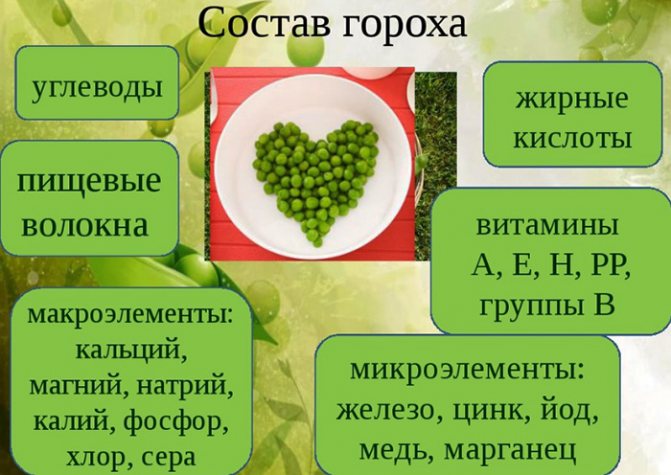
- if you add greens to the finished dish, it will help increase appetite and stimulate digestion;
- the fiber in the composition allows you to cleanse the digestive tract and get rid of constipation;
- the dish strengthens the heart muscle and improves blood circulation;
- Pea puree provides quick saturation and gives tone to the body.
Eating pea puree can negatively affect the functioning of the body.
A negative reaction is due to the following properties:
- if you have a history of problems with the gastrointestinal tract, the dish may cause increased gas formation and bloating;
- It is also necessary to limit the consumption of pea puree for people who have problems with the functioning of the kidneys, heart, or diabetes, since the dish can aggravate the chronic condition of the disease;
- Children under 3 years of age should avoid consuming pea puree, as the dish can cause increased gas formation and severe abdominal pain.
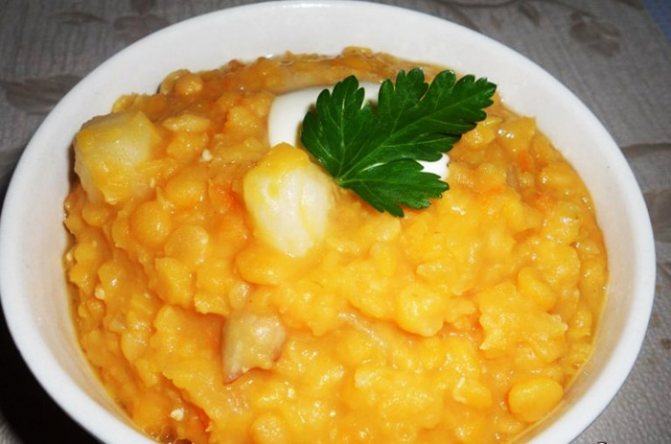
Pea puree is a dish that is prepared mainly in water with the addition of butter and salt. For people who are on a diet, there are some restrictions in preparing the dish to reduce its nutritional value.
The calorie content of the product can be reduced in the following ways:
- for cooking, you must choose frozen peas; after heat treatment, their calorie content will not exceed 33 kcal;
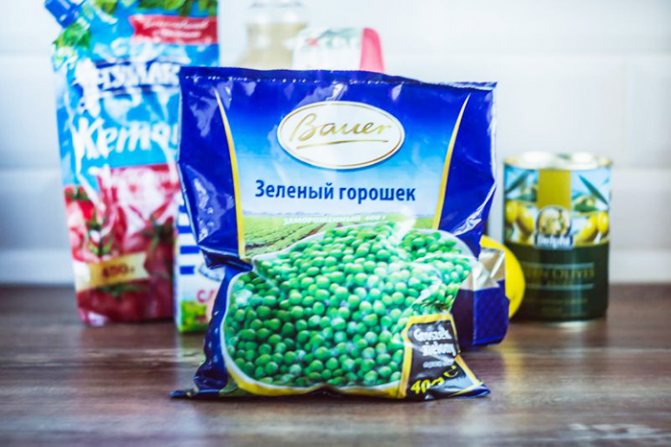
- if you cook peas with the addition of lean meat, the calorie content will be 50 kcal;
- Also, do not fry for pureed pea soup.
Harm
Undoubtedly, peas are a healthy and nutritious product, but they have a number of contraindications. The main ones are:
- Lactation period. This is due to the possibility of increased gas formation in the baby.
- Disruption of the digestive system due to high acidity of the stomach.
- Any pathological changes in the kidneys and liver.
- The product is difficult to digest, so it is undesirable in the diet of older people and children under three years of age.
Particular caution should be exercised by people prone to flatulence and bloating. Grains, due to the purines present in them, can cause the deposition of uric acid salts in the joints and kidneys. Strictly contraindicated for vascular thrombosis, cholecystitis and urolithiasis. In the acute stage of gastritis, legumes cannot be consumed in any form, but in mild cases of the disease, fresh green peas are acceptable. Pancreatitis excludes the intake of dry, boiled and fresh vegetables, but sprouted vegetables are not prohibited.
Even in the absence of health contraindications, it is necessary to adhere to the norm so as not to cause harm to health.
Use
When choosing peas, preference is given to split peas, which cook faster without losing the nutritional component. Ice cream will be a complete replacement for fresh, which does not make it any less beneficial for the body. Also pay attention to the size of the peas. The diameter is more than 4 mm and the purple color is not suitable: this is a fodder variety and will not be of any use. For culinary use, kernels of a bright orange tone are most suitable.
If you correctly include peas in your daily diet, there should be no negative consequences. In the first half of the day, it is recommended to eat soup and porridge, and all possible combinations with other products are not prohibited. In the evening, preference is given to the bean, sprouted and canned version.
The daily requirement is quite difficult to calculate, since this product is not usually eaten all the time. Approximate harmless portions: 150–170 grams canned, 100 grams boiled in water. You should not mix different types of legumes on the same day. If you eat porridge for breakfast, then you should stop there.
Peas are widely used in cooking, supporting many traditional recipes. To make a tasty and aromatic dish, you need to learn how to cook it properly.
Instructions for cooking peas:
- Dry seeds are pre-soaked in cold water for at least 6 hours. Cook over low heat, with the lid closed. When the liquid evaporates, only add boiling water, otherwise the taste will deteriorate.
- It’s much easier to cook in a multicooker: pour in the required volume and fill it with water in a ratio of 1:3. The timer is set to the “Stew” mode, cooking time is 2–2.5 hours.
The most interesting recipes are presented in the table:
| Dish | Preparation | Photo |
| Lenten pea soup | A tasty and nutritious dish, the taste is no worse than that cooked in meat broth. You will need any vegetables, fresh or frozen. Cooking process:
| |
| Pea-potato puree | For 3 servings you need:
Prepare as follows:
| |
| Young pea sauce | Product set:
All ingredients are placed in a blender bowl and blended until smooth. | |
| Porridge with smoked meats | Preparation:
|
Delicious pea puree recipes for regular and dietary meals
Pea puree, whose calorie content is lower when boiled in water, can be included in the diet if you want to lose weight. Since the dish contains vitamins and microelements that contribute to the rejuvenation and healing of the body, we can talk about the benefits of pea puree for weight loss.
To make pea puree tasty, you need to take into account the general recommendations for preparing this dish:
- peas must be washed 6 times before cooking;
- only dried beans are suitable for making porridge and puree;
- soaking peas should not last more than 12 hours, as the product will become hard;
- when soaking water, it is necessary to pour 2-3 cm more water, since the peas will increase in size;
- It is better to salt the dish at the end of cooking;
- the pan should not be covered with a lid during cooking;
- if the water has boiled away, you need to add the same amount of boiling water, not cold liquid.
For preparation you need the following ingredients:
- water – 4 tbsp.;
- peas – 300 g;
- carrots – 150 g;
- butter – 50 g;
- onions – 2 pcs.;
- garlic – 3 cloves;
- sunflower oil – 50 ml;
- salt - to taste.
Step-by-step cooking process:
- First, peas must be washed and soaked in water overnight.
- Then in the morning you need to add 1 tbsp to the container. water and put it on fire.
- Then, after boiling, you should reduce the heat to a minimum and continue cooking, stirring the peas, for 1-1.5 hours. If the water boils away, then it needs to be added.
- After time, the peas should be boiled. If this does not happen, you can beat it with a blender.
- Next, at the end of cooking, you need to add butter.
- While the peas are cooking, chop the onions and carrots, fry until golden brown and add chopped garlic.
Before serving pea puree, you need to add sauteed vegetables to it.
Calorie content – 187 kcal per 100 g of dish.
With milk
- peas – 500 g;
- milk – 500 ml;
- butter – 50 g;
- salt - to taste.
- Peas must be soaked in cold water for 4 hours.
- Next, without draining the water, you should boil the product.
- After cooking is finished, the liquid must be drained using a sieve and the peas must be beaten in a blender.
- Pour previously boiled milk into the whipped mass, add butter and salt.
- Pea puree should be mixed thoroughly.
You can serve the dish on its own or as an addition to potatoes.
Calorie content of 100 g of ready-made dish is 97 kcal.
With lard
- peas – 400 g;
- lard – 200 g;
- medium-sized onion – 4 pcs.;
- dill – 30 g;
- water or broth - 4 tbsp;
- salt - to taste.
- First, rinse the peas until the water runs clear. Next, the product should be soaked for 4-6 hours. When time has passed, the water should be drained.
- Next, add broth to the peas and cook. After boiling, reduce the heat to medium and continue cooking for another 50 minutes. If liquid remains, the dish must be cooked until it evaporates.
- Then the lard should be cut into cubes, and the onion into half rings.
- Next, you need to fry the lard on both sides until golden brown and place on a plate.
- After this, without washing the pan, fry the onion in the fat from the lard.
- Then, when the onion is ready, you need to turn off the heat and return the lard to the container.
Pea puree, whose calorie content is 300 kcal per 100 dishes, can be served by mixing all the ingredients or laying lard on top of the dish.
With mint
The following ingredients are needed for the cooking process:
- frozen green peas – 500 g;
- green onions – 50 g;
- mint – 30 g;
- butter – 40 g;
- vegetable oil – 30 g;
- salt and pepper - to taste.
We suggest you read: How to grow peas at home?
For cooking, you can take fresh green peas. With this component the finished dish will be sweeter.
- First, you need to thoroughly rinse the greens and shake off excess water.
- Next, the greens and mint should be cut into large pieces. At this stage, you should not grind the components, since later they will be ground in a blender.
- Pour vegetable oil into a heated frying pan and fry the green onions in it for 3 minutes. Next, add mint and fry for another 2 minutes.
- Then you need to pour the peas into the pan, wait until they defrost, and simmer for another 10 minutes.
- When the required time has passed, you need to turn off the heat, open the lid and add spices.
- Next, the finished mass must be placed in a deep container and blended with a blender.
- Then you need to add butter to the whipped puree.
You can serve mashed potatoes as a side dish or as an addition to the main dish.
Calorie content of 100 g of the finished product is 145 kcal.
- peas – 300 g;
- champignons – 300 g;
- carrots – 200 g;
- potatoes – 300 g;
- butter – 90 g;
- meat – 600 g;
- garlic – 3 cloves;
- cream – 100 ml;
- salt and spices - optional.
Step by step process for making gravy:
- First, the meat must be washed under water, then cut into cubes.
- Next, peel the onions and carrots. Then you need to cut the onion into cubes and grate the carrots.
- Then all the ingredients must be mixed in a frying pan, seasoned and simmered until the meat is cooked.
- Next, grate the champignons on a coarse grater and add to the meat, continue simmering for another 7 minutes.
- Then you need to pour the cream into the pan, let the mixture boil and add chopped garlic.

Pea puree is prepared as follows:
- First, the peas must be soaked for 4 hours.
- Next, in separate pans, boil the peas and potatoes until tender.
- Then you need to beat the peas with a blender, mash the potatoes and mix the ingredients, including the meat gravy.
- Then you need to add salt and butter to the finished mass.
You can serve the dish with a salad of fresh vegetables.
Calorie content of 100 g of ready-made dish is 200 kcal.
And a little about secrets...
The story of one of our readers Alina R.:
I was especially depressed about my weight. I gained a lot, after pregnancy I weighed as much as 3 sumo wrestlers together, namely 92 kg with a height of 165. I thought the belly would go away after giving birth, but no, on the contrary, I began to gain weight. How to cope with hormonal changes and obesity? But nothing disfigures or makes a person look younger than his figure. At the age of 20, I first learned that plump girls are called “WOMAN” and that “they don’t make clothes that size.” Then at the age of 29, divorce from her husband and depression...
But what can you do to lose weight? Laser liposuction surgery? I found out - no less than 5 thousand dollars. Hardware procedures - LPG massage, cavitation, RF lifting, myostimulation? A little more affordable - the course costs from 80 thousand rubles with a nutritionist consultant. You can, of course, try to run on a treadmill until you go crazy.
And when will you find time for all this? And it's still very expensive. Especially now. Therefore, I chose a different method for myself...
